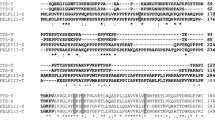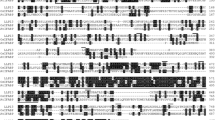Abstract
We previously isolated a pollen-specific gene encoding a pollen tube wall-associated glycoprotein with a globular domain and an extensin domain from maize (mPex1). To evaluate which protein domains might be important for function, we isolated a second monocot gene (mPex2) and a dicot gene (tPex). Each gene encodes a signal sequence, an N-terminal globular domain comprised of a variable region, a leucine-rich repeat (LRR) with an adjacent cysteine-rich region, a transition region and an extensin-like C-terminal domain. The LRRs of the maize and tomato Pex proteins are highly conserved. Although the extensin domains in the maize and tomato proteins vary in length and in amino acid sequence, they are likely to be structurally conserved. Additional putative Pex gene sequences were identified by either GenBank search (Arabidopsis) or PCR (sorghum and potato); all encode conserved LRRs. The presence of a conserved LRR in the known and potential Pex proteins strongly suggests that this motif is involved in the binding of a specific ligand during pollen tube growth. Gene expression studies using RNA and protein blotting as well as promoter-reporter gene fusions in transient and stable transformation indicate that the tomato Pex gene is pollen-specific.
Similar content being viewed by others
References
Adair, W.S., Hwang, C. and Goodenough, U.W. 1983. Identification and visualization of the sexual agglutinin from the Mating-Type Plus flagellar membrane of Chlamydomonas. Cell 33: 183–193.
Baldwin, T.C., Coen, E.S. and Dickinson, H.G. 1992. The ptl1 gene expressed in the transmitting tissue of Antirrhinum encodes an extensin-like protein. Plant J. 2: 733–739.
Barnabas, B. and Fridvasky, L. 1984. Adhesion and germination of differently treated maize pollen grains on the stigma. Acta Bot. Hung. 30: 329–332.
Bedinger, P. 1992. The remarkable biology of pollen. Plant Cell 4: 879–887.
Botella, M., Parker, J., Frost, L., Bittner-Eddy, P., Beynon, J., Daniels, M., Holub, E. and Jones, J. 1998. Three genes of the Arabidopsis RPP1 complex resistance locus recognize distinct Peronospora parasitica avirulence determinants. Plant Cell 10: 1847–1860.
Cassab, G.I. 1998. Plant cell wall proteins. Annu. Rev. Plant Physiol. Plant Mol. Biol. 49: 281–309.
Chen, C.-G., Cornish, E.D. and Clarke, A.E. 1992. Specific expression of an extensin-like gene in the style of Nicotiana alata.Plant Cell 4: 1053–1062.
Cheung, A.Y., Wang, H. and Wu, H.-M. 1995. A floral transmitting tissue-specific glycoprotein attracts pollen tubes and stimulates their growth. Cell 82: 383–393.
Chou, P. and Fasman, G. 1978. Prediction of the secondary structure of proteins from their amino acid sequence. Adv. Enzymol. 47: 45–148.
Chrispeels, M. 1969. Synthesis and secretion of hydroxyproline containing macromolecules in carrots I. Kinetic analysis. Plant Physiol. 44: 1187–1193.
Cooper, J.B., Adair, W.S., Mecham, R.P., Heuser, J.E. and Goodenough, U.W. 1983. Chlamydomonas agglutinin is a hydroxyproline-rich glycoprotein. Proc. Natl. Acad. Sci. USA 80: 5898–5901.
Emini, E., Hughes, J., Perlow, D. and Boger, J. 1985. Induction of hepatitis A virus-neutralizing antibody by a virus-specific synthetic peptide. J. Virol. 55: 836–839.
Epstein, L. and Lamport, D. 1984. An intramolecular linkage involving isodityrosine in extensin. Phytochemistry 23: 1241–1246.
Eyal, Y., Curie, C. and McCormick, S. 1995. Pollen specificity elements reside in 30 bp of the proximal promoters of two pollen-expressed genes. Plant Cell 7: 373–384.
Ferguson, C., Teeri, T., Siika-aho, M., Read, S. and Bacic, A. 1998. Location of cellulose and callose in pollen tubes and grains of Nicotiana tabacum. Planta 206: 452–460.
Fletcher, J.C., Brand, U., Running, M.P., Simon, R. and Meyerowitz, E.M. 1999. Signaling of cell fate decisions by CLAVATA3 i n Arabidopsis shoot meristems. Science 283: 1911–1194.
Fry, S.C. 1986. Cross-linking of matrix polymers in the growing cell walls of angiosperms. Annu. Rev. Plant Physiol. 37: 165–186.
Goldman, M.H., Pezzotti, M., Seurinck, J. and Mariani, C. 1992. Developmental expression of tobacco pistil-specific genes encoding novel extensin-like proteins. Plant Cell 4: 1041–1051.
Hamilton, D.A., Schwarz, Y.H., Rueda, J. and Mascarenhas, J.P. 2000. Comparison of transient and stable expression by a pollen-specific promoter: the transformation results do not always agree. Sex. Plant Reprod. 12: 292–295.
Heslop-Harrison, J. 1987. Pollen germination and pollen tube growth. Int. Rev. Cytol. 107: 1–78.
Heslop-Harrison, Y., Reger, B.J. and Heslop-Harrison, J. 1984. The pollen-stigma interaction in the grasses. 6. The stigma ('silk') of Zea mays L. as host to the pollens of Sorghum bicolor (L.) Moench and Pennisetum americanum (L.) Leeke. Acta Bot. Neerl. 33: 205–227.
Hills, G.J., Phillips, J.M., Gay, M.R. and Roberts, K. 1975. Self-assembly of a plant cell wall in vitro. J. Mol. Biol. 96: 431–441.
Jauh, G.Y. and Lord, E.M. 1996. Localization of pectins and AGPs in lily pollen tube and style and their possible roles in pollination. Planta 199: 251–261.
Jeanmougin, F., Thompson, J., Gouy, M., Higgins, D. and Gibson, T. 1998. Multiple sequence alignment with Clustal X. Trends Biochem. 23: 403–405.
Jefferson, R., Kavanagh, T. and Bevan, M. 1987. GUS fusions: β-glucuronidase as a sensitive and versatile gene fusion marker in higher plants. EMBO J. 6: 3901–3907.
Jones, D. and Jones, J. 1996. The roles of leucine rich repeats in plant defences. Adv. Bot. Res. Plant Path. 24: 90–167.
Kieliszewski, M.J. and Lamport, D.T.A. 1994. Extensin: repetitive motifs, functional sites, post-translational codes, and phylogeny. Plant J. 5: 157–172.
Kieliszewski, M.J., O'Neill, M., Leykam, J. and Orlando, R. 1995. Tandem mass spectrometry and structural elucidation of glycopeptides from a hydroxyproline-rich plant cell wall glycoprotein indicate that contiguous hydroxyproline residues are the major sites of hydroxyproline O-arabinosylation. J. Biol. Chem. 270: 2541–2549.
Kneller, D., Cohen, F. and Langridge, R. 1990. Improvements in protein secondary structure prediction by an enhanced neural network. J. Mol. Biol. 214: 171–182.
Kobe, B. and Deisenhofer, J. 1994. The leucine-rich repeat: a versatile binding motif. Trends Biol. Sci. 19: 415–421.
Kobe, B. and Deisenhofer, J. 1995. Proteins with leucine-rich repeats. Curr. Opin. Struct. Biol. 5: 409–416.
Lamport, D.T.A. 1963. Oxygen fixation into hydroxyproline of plant cell wall protein. J. Biol. Chem. 238: 1438–1440.
Lamport, D.T.A. 1965. The protein component of primary cell walls. Adv. Bot. Res. 2: 151–218.
Lamport, D.T.A. 1977. Structure, biosynthesis, and significance of cell wall glycoproteins. In: F.A. Loewus and V.C. Runeckles (Eds.) Rec. Adv. Phytochem. 11: 79–115.
Li, Y.-Q., Bruun, L., Pierson, E.S. and Cresti, M. 1992. Periodic deposition of arabinogalactan epitopes in the cell wall of pollen tubes of Nicotiana tabacum L. Planta 188: 532–538.
Lind, J.L., Bacic, A., Clarke, A. and Anderson, M.A. 1994. A style-specific hydroxyproline-rich glycoprotein with properties of both extensins and arabinogalactan proteins. Plant J. 6: 491–502.
Logeman, J., Jeanmougin, F., Schell and Willmitzer, L. 1987. Improved method for the isolation of RNA from plant tissues. Anal. Biochem. 163: 16–20.
Mascarenhas, J.P. 1993. Molecular mechanisms of pollen tube growth and differentiation. Plant Cell 5: 1303–1314.
McCormick, S. 1991. Transformation of tomato with Agrobacterium tumefaciens. In: K. Lindsey (Ed.) Plant Tissue Culture Manual: Fundamentals and Applications, Kluwer Academic Publishers, Dordrecht, Netherlands.
McCormick, S., Smith, A., Gasser, C., Sachs, K., Hinchee, M., Horsch, R. and Fraley, R. 1987. Identification of genes specifically expressed in reproductive organs of tomato. In: D. Nevins and R. Jones (Eds.) Tomato Biotechnology, Alan R.Liss, New York, pp. 255–265.
McDowell, J., Dhandayham, M., long, T., Aarts, M., Goff, S., Holub, E. and Dangl, J. 1998. Intragenic recombination and diversifying selection contribute to the evolution of downy mildew resistance in the RPP8 locus of Arabidopsis. Plant Cell 10: 1861–1874.
McLelland, J. and Rumelhart, D. 1988. Explorations in parallel distributed processing: a handbook of models, programs and exercises, MIT Press, Cambridge, MA.
Meyer, Y. and Abel, W.D. 1975. Importance of the cell wall for cell division and in the activity of the cytoplasm in cultured tobacco protoplasts. Planta 123: 33–40.
Muschietti, J., Eyal, Y. and McCormick, S. 1998. Pollen tube localization implies a role in pollen-pistil interactions for the tomato receptor-like protein kinases LePRK1 and LePRK2. Plant Cell 10: 319–330.
Rubinstein, A.L., Broadwater, A.H., Lowrey, K.B. and Bedinger, P.A. 1995a. Pex1, a pollen-specific gene with an extensin-like domain. Proc. Natl. Acad. Sci. USA 92: 3086–3090.
Rubinstein, A.L., Marquez, J., Suarez-Cervera, M. and Bedinger, P.A. 1995b. Extensin-like glycoproteins in the maize pollen tube wall. Plant Cell 7: 2211–2225.
Sambrook, J., Fritsch, E. and Maniatis, T. 1989. Molecular Cloning: A Laboratory Manual, 2nd ed. Cold Spring Harbor Laboratory Press, Plainview, NY.
Showalter, A., Bell, J., Cramer, C., Bailey, J., Varner, J. and Lamb, C. 1985. Accumulation of hydroxyproline-rich glycoprotein mRNAs in response to fungal elicitor and infection. Proc. Natl. Acad. Sci USA 82: 6551–6555.
Showalter, A.M. 1993. Structure and function of plant cell wall proteins. Plant Cell 5: 9–23.
Steer, M.W. and Steer, J.M. 1989. Tansley Review No. 16. Pollen tube tip growth. New Phytol. 111: 323–358.
Trotochaud, A.E., Jeong, S., and Clark, S.E. 2000. CLAVATA3, a multimeric ligand for the CLAVATA1 receptor-kinase. Science 289: 613–617.
Twell, D., Yamaguchi, J., Wing, R.A., Ushiba, J. and McCormick, S. 1991. Promoter analysis of genes that are coordinately expressed during pollen development reveals pollen-specific enhancer sequences and shared regulatory elements. Genes Dev. 5: 496–507.
van Holst, G. and Varner, J. 1984. Reinforced polyproline II conformation in a hydroxyproline-rich cell wall glycoprotein from carrot root. Plant Physiol. 74: 247–251.
von Heijne, G. 1986. A new method for predicting signal sequence cleavage sites. Nucl. Acids Res. 14: 4683–3690.
Waffenschmidt, S., Woessner, J.P., Beer, K. and Goodenough, U.W. 1993. Isodityrosine cross-linking mediates insolubilization of cell walls in Chlamydomonas. Plant Cell 5: 809–820.
Wu, H.-M., Zou, J., May, B., Gu, Q. and Cheung, A.Y. 1993. A tobacco gene family of flower cell wall proteins with a proline-rich and a cysteine-rich domain. Proc. Natl. Acad. Sci. USA 90: 6829–6833.
Author information
Authors and Affiliations
Rights and permissions
About this article
Cite this article
Stratford, S., Barnes, W., Hohorst, D.L. et al. A leucine-rich repeat region is conserved in pollen extensin-like (Pex) proteins in monocots and dicots. Plant Mol Biol 46, 43–56 (2001). https://doi.org/10.1023/A:1010659425399
Issue Date:
DOI: https://doi.org/10.1023/A:1010659425399




